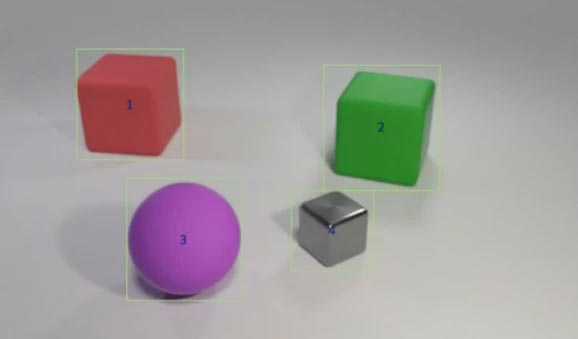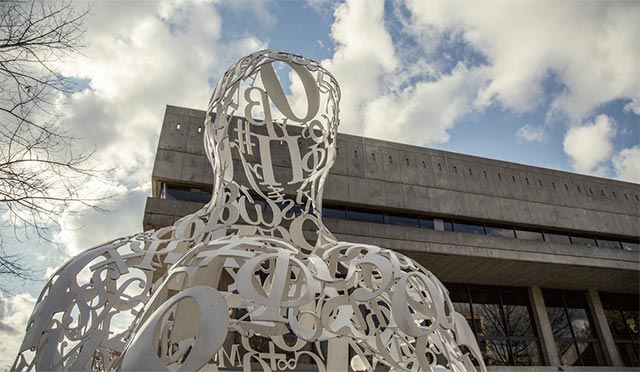MIT AI model can capture the relationship between objects with the minimum amount of training data
Deep learning systems work by selecting statistical patterns in data - that's how they interpret their own worldview. However, this method of statistical learning requires a large amount of input data, and is not particularly useful in helping deep learning systems apply knowledge from the past to new situations, unlike as symbolic AI (symbolic AI), allows to record the sequence of steps taken to make decisions with less data than traditional methods.

- The 'Nobel technology' award is awarded to AI-teaching software as human
A new study was conducted by a group of artificial intelligence scientists at MIT, MIT-IBM Watson AI Lab and DeepMind showing the potential of symbolic training methods AI when applied to a specific task, eg capture the meaning of images. Accordingly, in the experiments, the AI model of the scientists learned concepts related to objects such as color and shape, and then used that knowledge to create relationships between many object in a scene, while only requires minimal training data and does not need to be programmed clearly.
'We all know that using a combination of words and illustrations is an effective way to help children learn and remember a specific concept. Our idea of this symbolic AI model is the same. As a result, the system will need less training data, while being able to transfer knowledge that it has acquired to better new situations, 'said computer scientist Jiayuan Mao, who heads the project. study sharing.

- Google researchers for gaming AI to improve enhanced learning ability
Basically, this AI model consists of an information receiving component, which helps transform images into object-based interpretations, and a language class that extracts meaning from words and sentences. , then create 'symbolic programs' that help AI know how to answer questions. In addition, there will be an additional third module running icon programs on the background and giving an answer, updating knowledge to the AI model when it makes a mistake.
Researchers have trained this AI model on images associated with many relevant questions and answers. The ability to understand the image of the AI is then monitored by Stanford University. In general, AI must answer questions like: What is the color of the object? How many objects are next to another object? Or what material is this object made of? The complexity of the questions will naturally increase with the level of the AI model, and when mastering the concept of object level, the AI model will learn how to link between multiple objects and objects. Their properties together, this can be considered an advanced stage.

- Winnow uses computer vision to help cut waste in food processing
In experiments, this AI model shows that it can interpret new scenes and concepts that are almost perfect, completely superior to other advanced AI systems, while using only 5,000 images. photos and 100,000 questions (compared to about 70,000 images and 700,000 questions of common AI models). In the future, the researchers' main work will be to improve the performance of the AI model in understanding real-world photographs, then gradually moving toward the object of video and robot manipulation.
You should read it
- Deep Learning - new cybersecurity tool?
- AI engineer Facebook talks about deep learning, new programming languages and hardware for artificial intelligence
- Google researchers for gaming AI to improve enhanced learning ability
- This robot only takes 2 hours to learn to walk by itself
- Microsoft announced DeepSpeed, a new deep learning library that can support the training of super-large scale AI models
- AI uses WiFi data to estimate the number of people in a room
- Nvidia launches Deep Learning Super Sampling 2.0, an advanced platform for rendering AI-based graphics
- Admire Nvidia's new AI application: Turn MS Paint-style doodle into an artistic 'masterpiece'
May be interested
- How to Calculate Data Transfer Speed
 data transfer rate (dtr) is the rate at which a certain amount of data is transferred in a specific period of time. you'll probably want to know what this speed is if you're downloading something from the internet or transferring data from one source to another. first, change the units so that the file size and transfer rate are both bits or bytes and have the same prefix (kilo, mega, giga, or tera). then plug your numbers into the formula s = a ÷ t, where a is the amount of data and t is the transmission time to calculate s (transfer rate). you can also calculate the amount of data or transfer time if you know either of these variables and the transfer rate.
data transfer rate (dtr) is the rate at which a certain amount of data is transferred in a specific period of time. you'll probably want to know what this speed is if you're downloading something from the internet or transferring data from one source to another. first, change the units so that the file size and transfer rate are both bits or bytes and have the same prefix (kilo, mega, giga, or tera). then plug your numbers into the formula s = a ÷ t, where a is the amount of data and t is the transmission time to calculate s (transfer rate). you can also calculate the amount of data or transfer time if you know either of these variables and the transfer rate. - 1-n relationship between tables in Access
 the 1-n relationship is the type of relationship in which a record in the table may have multiple matching records in another table, but a record in the second table only has one matching record in the first table.
the 1-n relationship is the type of relationship in which a record in the table may have multiple matching records in another table, but a record in the second table only has one matching record in the first table. - How to Maintain a Relationship with a Quiet Person
 maintaining a relationship of any kind takes effort, compromise, and communication on the part of both of people. it can be challenging, though, if your partner is a quiet person. you way wonder what you need to do to keep the relationship...
maintaining a relationship of any kind takes effort, compromise, and communication on the part of both of people. it can be challenging, though, if your partner is a quiet person. you way wonder what you need to do to keep the relationship... - How to delete objects and objects in Photoshop
 how to delete objects and objects in photoshop. while taking photos sometimes we cannot help but encounter flaws such as the wrong angle leading to 'uninvited' objects appearing in our photographs. fortunately, photo editing software specializes n
how to delete objects and objects in photoshop. while taking photos sometimes we cannot help but encounter flaws such as the wrong angle leading to 'uninvited' objects appearing in our photographs. fortunately, photo editing software specializes n - Relationship in MongoDB
 relationship in mongodb represents how the documents are related. relationship can be modeled through the embeded and referenced method.
relationship in mongodb represents how the documents are related. relationship can be modeled through the embeded and referenced method. - The 10 Stages of a Relationship That Every Couple Should Understand
 from getting to know a person to breaking up, there are ten different stages of a relationship that you may experience. learn about what they are and why they're important.
from getting to know a person to breaking up, there are ten different stages of a relationship that you may experience. learn about what they are and why they're important. - Graph data structure (Graph)
 a graph (graph) is a form of visual representation of a set of objects in which pairs of objects are connected by links. interconnected objects are represented by points called vertices, and links that connect vertices are called edges.
a graph (graph) is a form of visual representation of a set of objects in which pairs of objects are connected by links. interconnected objects are represented by points called vertices, and links that connect vertices are called edges. - AI tools are running out of training data
 artificial intelligence (ai) needs training data, but that data is limited. so, how else can ai be trained so that it continues to develop and be useful to us?
artificial intelligence (ai) needs training data, but that data is limited. so, how else can ai be trained so that it continues to develop and be useful to us? - 8 signs of your relationship will not go anywhere
 surely many people are feeling anxious about their emotional relationship, right? let's tipsmake.com point through 8 signs that your relationship will not go to a good future below!
surely many people are feeling anxious about their emotional relationship, right? let's tipsmake.com point through 8 signs that your relationship will not go to a good future below! - The minimum courtesy everyone should know when in the gym room
 the gym is like many other public places, so we go there to know the rules as well as keep the minimum courtesy in crowded places, avoiding disturbing effects to everyone around.
the gym is like many other public places, so we go there to know the rules as well as keep the minimum courtesy in crowded places, avoiding disturbing effects to everyone around.










 Chatbot AI supports finding information about frauds and frauds
Chatbot AI supports finding information about frauds and frauds OpenAI artificial intelligence defeated 5 professional Dota 2 players
OpenAI artificial intelligence defeated 5 professional Dota 2 players How can the AI see us behind the walls?
How can the AI see us behind the walls? Google's DeepMind can diagnose eye diseases exactly like doctors
Google's DeepMind can diagnose eye diseases exactly like doctors Microsoft artificial intelligence application can admire the poetic landscape, invite you to enjoy
Microsoft artificial intelligence application can admire the poetic landscape, invite you to enjoy This is how AI defeats the best Dota 2 players
This is how AI defeats the best Dota 2 players